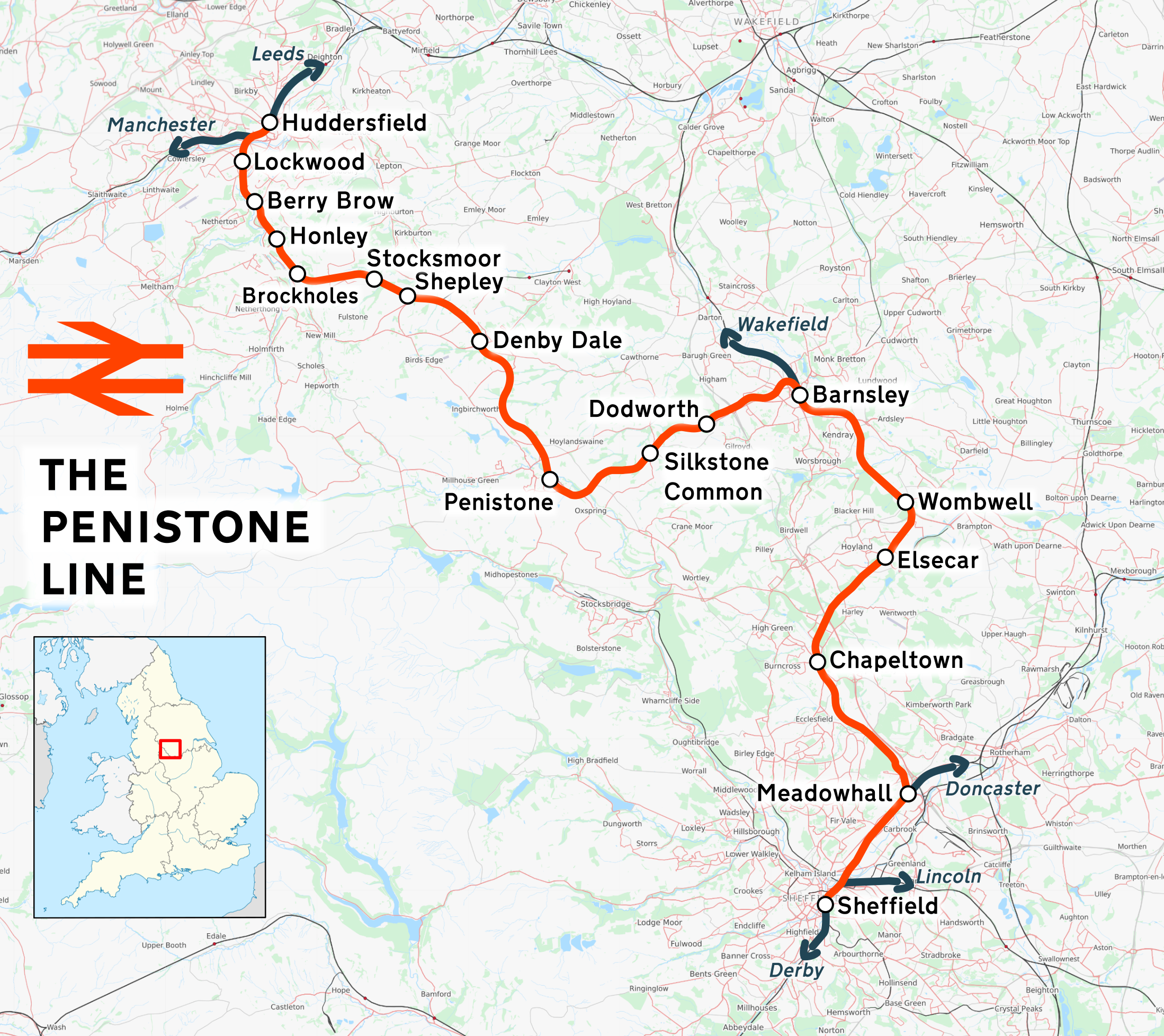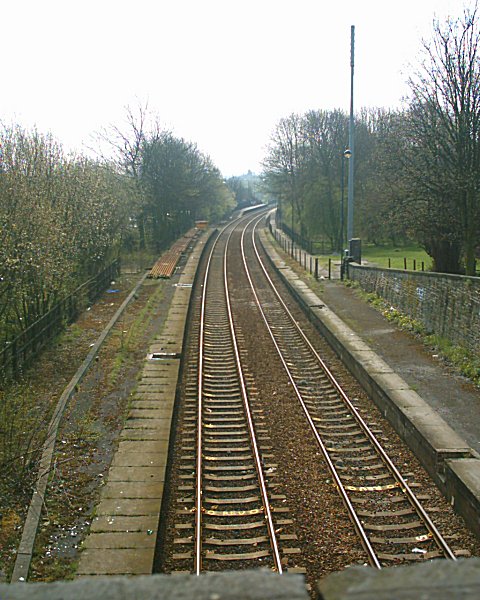|
Chapeltown Central Railway Station
Chapeltown Central railway station was situated on the former South Yorkshire Railway's Blackburn Valley line between Ecclesfield East and Westwood. The station which was also known as Chapeltown and Thorncliffe was intended to serve Chapeltown, South Yorkshire, England, although about from its centre. It also served the works of Newton, Chambers & Company, one of the largest industrial companies in the area. The original station which was mainly constructed of wood opened in 1854. The line at the time was only a single track and this was increasingly recognised as a bottle neck so plans were made to double this which began in 1875 and a new larger station was to be built on the north side of the track. The new station was built in the M.S.& L.R.'s ''Double Pavilion'' style and the building consisted of a station master's house, booking office, goods office, and first, second and third class waiting rooms. In order to make room for this an existing goods warehouse was demoli ... [...More Info...] [...Related Items...] OR: [Wikipedia] [Google] [Baidu] |
Chapeltown, South Yorkshire
Chapeltown is a large village and suburb of Sheffield in South Yorkshire, England. It is part of the Parish of Ecclesfield. It is historically within the West Riding of Yorkshire. Geography Chapeltown is located approximately north of Sheffield city centre on the railway between Sheffield and Barnsley. Chapeltown railway station is served by the Penistone Line and Hallam Line. Two junctions of the M1 motorway also serve the area. The A6135 road passes through the town from north to south and is joined near the town centre by the A629 road from the south-east and the B6546 road from the west. Like much of Sheffield, there is a large amount of greenspace in and around Chapeltown. The town centre has a cricket ground and a wooded park on either side of it. Between Chapeltown and Ecclesfield the land is used for residential purposes on one side of the main road and agricultural on the other. There is also a brownfield site above the park. History Until industrial expansio ... [...More Info...] [...Related Items...] OR: [Wikipedia] [Google] [Baidu] |
Lepidodendron
''Lepidodendron'' is an extinct genus of primitive vascular plants belonging to the family Lepidodendraceae, part of a group of Lycopodiopsida known as scale trees or arborescent lycophytes, related to Isoetes, quillworts and Lycopodiopsida, lycopsids (club mosses). They were part of the coal forest flora. They sometimes reached heights of , and the trunks were often over in diameter. They thrived during the Carboniferous Period (358.9 to 298.9 million years ago). Sometimes erroneously called "giant club mosses", the genus was actually more closely related to modern quillworts than to modern club mosses. Within the form classification system used within paleobotany, ''Lepidodendron'' is both used for the whole plant as well as specifically the stems and leaves. Etymology The name ''Lepidodendron'' comes from the Greek language, Greek wikt:λεπίς, λεπίς ', scale, and wikt:δένδρον, δένδρον ''dendron'', tree. Growth During the early stages of growth, ''L ... [...More Info...] [...Related Items...] OR: [Wikipedia] [Google] [Baidu] |
Railway Stations In Great Britain Closed In 1953
Rail transport (also known as train transport) is a means of transport that transfers passengers and goods on wheeled vehicles running on rails, which are incorporated in tracks. In contrast to road transport, where the vehicles run on a prepared flat surface, rail vehicles (rolling stock) are directionally guided by the tracks on which they run. Tracks usually consist of steel rails, installed on sleepers (ties) set in ballast, on which the rolling stock, usually fitted with metal wheels, moves. Other variations are also possible, such as "slab track", in which the rails are fastened to a concrete foundation resting on a prepared subsurface. Rolling stock in a rail transport system generally encounters lower frictional resistance than rubber-tyred road vehicles, so passenger and freight cars (carriages and wagons) can be coupled into longer trains. The operation is carried out by a railway company, providing transport between train stations or freight customer facili ... [...More Info...] [...Related Items...] OR: [Wikipedia] [Google] [Baidu] |
Railway Stations In Great Britain Opened In 1854
Rail transport (also known as train transport) is a means of transport that transfers passengers and goods on wheeled vehicles running on rails, which are incorporated in tracks. In contrast to road transport, where the vehicles run on a prepared flat surface, rail vehicles (rolling stock) are directionally guided by the tracks on which they run. Tracks usually consist of steel rails, installed on sleepers (ties) set in ballast, on which the rolling stock, usually fitted with metal wheels, moves. Other variations are also possible, such as "slab track", in which the rails are fastened to a concrete foundation resting on a prepared subsurface. Rolling stock in a rail transport system generally encounters lower frictional resistance than rubber-tyred road vehicles, so passenger and freight cars (carriages and wagons) can be coupled into longer trains. The operation is carried out by a railway company, providing transport between train stations or freight customer facil ... [...More Info...] [...Related Items...] OR: [Wikipedia] [Google] [Baidu] |
Penistone Line
The Penistone Line is operated by Northern Trains in the West Yorkshire Metro and Travel South Yorkshire areas of northern England. It connects Huddersfield and Sheffield via Penistone and Barnsley, serving many rural communities. Metrocards (Zone 5) can be used for travel between Huddersfield and Denby Dale and intermediate stations. Line details Huddersfield–Penistone The first section of line between and was opened on 1 July 1850 by the Lancashire and Yorkshire Railway (L&YR). From the joint L&YR/ London and North Western Railway Huddersfield station, trains ran south to Springwood Junction (south of Huddersfield) on the London and North Western Railway Leeds–Manchester main line, where the L&YR line began; from there the route was as follows: * ''Springwood Tunnel'' * * ''Meltham Branch Junction'' was the junction for the now disused Meltham branch line * ''Lockwood Viaduct'' * * ''Robin Hood Tunnel'' * ''Honley Tunnel'' * * was the junction for the now c ... [...More Info...] [...Related Items...] OR: [Wikipedia] [Google] [Baidu] |
Hallam Line
The Hallam Line is a railway connecting Leeds and Sheffield via Castleford in the West Yorkshire Metro area of northern England. It is a slower route from Leeds to Sheffield than the Wakefield line. Services on this line are operated by Northern. Services from Leeds to Nottingham also use the line. West Yorkshire MetroCards are available on trains between Leeds and Darton, north of Barnsley and South Yorkshire Travelmaster tickets are available in the South Yorkshire area. Origin of name The line is named after the manor of Hallam which included Sheffield at the time of the Domesday Book (1086). At this time the local area was known as ''Hallamshire''—the names ''Hallam'' and ''Hallamshire'' are still used today by many local companies and organisations. History Before the 1923 grouping the route followed by the line was owned as follows: * Leeds–Methley: Midland Railway * Methley–Normanton: Midland Railway * Methley–Castleford–Normanton: North Eastern Railway : ... [...More Info...] [...Related Items...] OR: [Wikipedia] [Google] [Baidu] |
Chapeltown Railway Station
Chapeltown railway station, originally known as Chapeltown South, is a railway station serves the Sheffield suburb of Chapeltown in South Yorkshire, England. The station is north of Sheffield on the Hallam and Penistone Lines. History The present station was the first to be opened under the governance of the South Yorkshire Passenger Transport Executive in 1984; the original station, just over nearer to Barnsley, closed at the same time. The platforms, shown in the photograph of the old station looking towards the new station just visible in the distance, were retained, the Barnsley-bound platform being used as a walkway to connect the original access to the new station. CCTV was installed in March 2008 for the purposes of crime prevention. Improvements to the station included new signs, lighting, nosing on the steps, and for the first time, installation of passenger information display screens (passenger information system) to provide real-time service information. The ... [...More Info...] [...Related Items...] OR: [Wikipedia] [Google] [Baidu] |
Sheffield Botanical Gardens
The Sheffield Botanical Gardens are botanical gardens situated off Ecclesall Road in Sheffield, England, with 5,000 species of plants in 19 acres (77,000 m2) of land. The gardens were designed by Robert Marnock and first opened in 1836. The most notable feature of the gardens are the Grade II* listed glass pavilions, restored and reopened in 2003. Other notable structures are the main gateway, the south entrance lodge and a bear pit containing an 8' tall steel statue of an American Black Bear called Robert the Bear. In the rose garden is a bronze sculpture "Pan: Spirit of the Wood", a gift in 1934 from Sir Charles Clifford, owner of the '' Sheffield Telegraph and Star'', to the city. The sculptor is not known. The Sheffield Botanical and Horticultural Society was formed in 1833 and by 1834 had obtained £7,500 in funding. The money was raised selling shares, permitting the purchase of of south-facing farmland from the estate of local snuff manufacturer Joseph Wilson. ... [...More Info...] [...Related Items...] OR: [Wikipedia] [Google] [Baidu] |
Manchester, Sheffield And Lincolnshire Railway
The Manchester, Sheffield and Lincolnshire Railway (MS&LR) was formed in 1847 when the Sheffield, Ashton-under-Lyne and Manchester Railway joined with authorised but unbuilt railway companies, forming a proposed network from Manchester to Grimsby. It pursued a policy of expanding its area of influence, especially in reaching west to Liverpool, which it ultimately did through the medium of the Cheshire Lines Committee network in joint partnership with the Great Northern Railway and the Midland Railway. Its dominant traffic was minerals, chiefly coal, and the main market was in London and the south of England. It was dependent on other lines to convey traffic southward. The London and North Western Railway was an exceptionally hostile partner, and in later years the MS&LR allied itself with the Great Northern Railway. Passenger traffic, especially around Manchester, was also an important business area, and well-patronised express trains to London were run in collaboration with th ... [...More Info...] [...Related Items...] OR: [Wikipedia] [Google] [Baidu] |
City Of Sheffield
The City of Sheffield is a city and metropolitan borough in South Yorkshire, England. The metropolitan borough includes the administrative centre of Sheffield, the town of Stocksbridge and larger village of Chapeltown and part of the Peak District. It has a population of 584,853 (mid-2019 est), making it technically the third largest city in England by population behind Birmingham and Leeds, since London is not considered a single entity. It is governed by Sheffield City Council. The current city boundaries were set on 1 April 1974 by the provisions of the Local Government Act 1972, as part a reform of local government in England. The city is a merger of two former local government districts; the unitary City and County Borough of Sheffield combined with the urban district of Stocksbridge and parts of the rural district of Wortley from the West Riding of Yorkshire. For its first 12 years the city had a two-tier system of local government; Sheffield City Council shar ... [...More Info...] [...Related Items...] OR: [Wikipedia] [Google] [Baidu] |
Chapeltown Central Station 2017 , estate in East Ayrshire, Scotland
{{geodis ...
Chapeltown may refer to: *Chapeltown, Lancashire, a village in the borough of Blackburn with Darwen * Chapeltown, South Yorkshire, a suburb of Sheffield *Chapeltown, Leeds, a suburb of Leeds *Chapeltown, County Kerry, a village on Valentia Island See also * Chapelton (other) *Chapeltoun Chapeltoun is an estate on the banks of the Annick Water in East Ayrshire, a rural area of Scotland famous for its milk and cheese production and the Ayrshire or Dunlop breed of cattle. Templeton and the Knights Templar The feudal allocatio ... [...More Info...] [...Related Items...] OR: [Wikipedia] [Google] [Baidu] |







